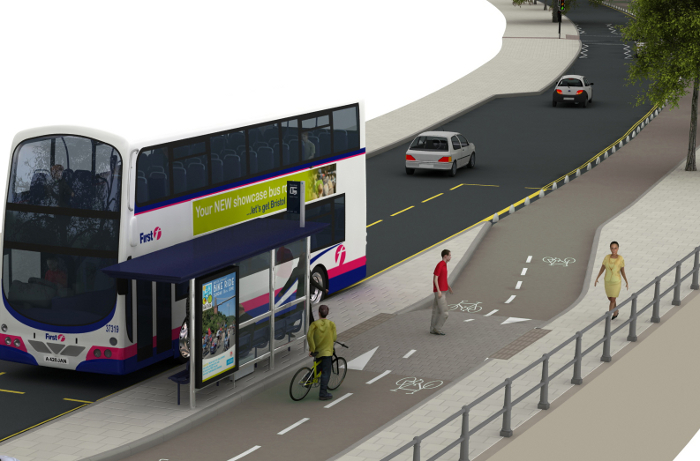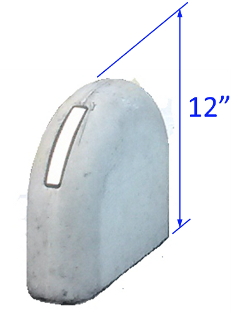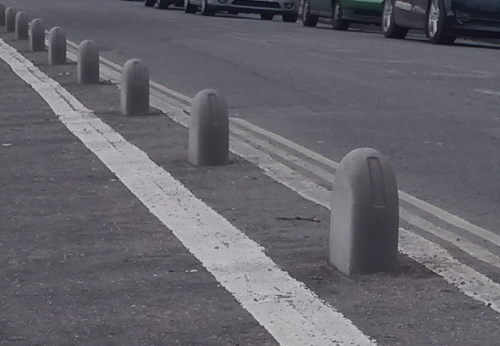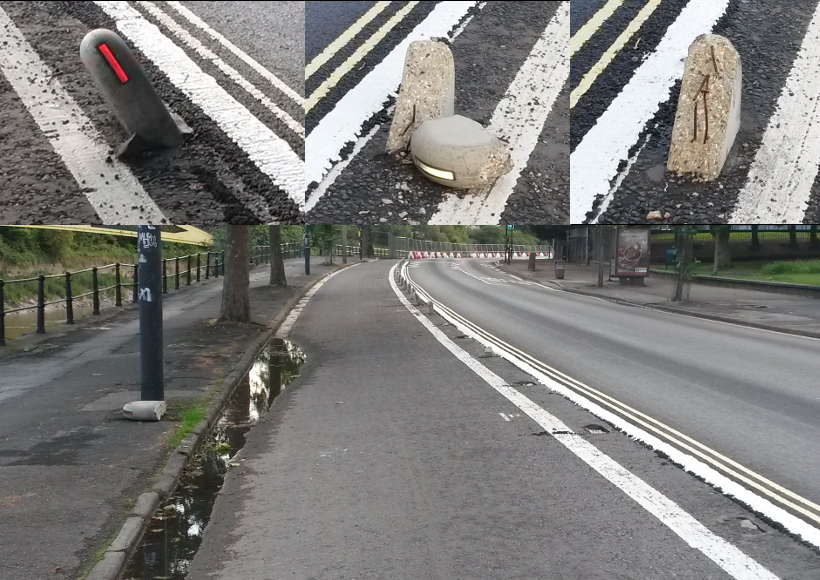



We've highlighted the issue of Toby - or "Tombstone" bollards a few times over the last year since they first appeared in Bristol. Now - after many months of warnings and a couple of incidents - it seems we have a victory for common sense and that the tale of woe might have a happy (ever after?) ending.
In 2014 Bristol City Council (BCC) designed and built a 700m long Dutch-style cycle path along Clarence Road, just around the corner from Temple Meads railway station. It was intended to be the first in a series linking Keynsham in the east to Hotwells in the west.
At that time the Mayor of Bristol George Ferguson declared "This scheme is exactly what we are going to see more of in Bristol as cycling and walking routes are improved.. ..separation really works where roads are busy and we can find the room".
The scheme was built as a trial and if deemed a success then similar types of segregation would be rolled out along many of the segregated cycle paths destined for Bristol's congested roads.

Going Dutch: cycle lane looks good with ideal lighting, light traffic and everyone being sensible. The public consultation showed the bollards as a similar height normal kerbs, and at ~500mm intervals

It doesn't matter how rounded and friendly you make it, it's still a serious accident waiting to happen
Yes, separation is great. It keeps cyclists safer from the same careless and impatient driving that motorcyclists suffer, and it also keeps us safe from the pedalists that can't tell green lights from red.
The problem is that separation takes a lot of space (and money) to do properly, and as MAG members will know there are many councils across the country that are trying to do it on the cheap with Armadillo and Orca "light segregation" devices.
Encouragingly the Bristol Council team recognised that these weren't popular with either the cyclists they were meant to protect or with riders of Powered Two Wheelers (PTWs).
Armadillos and Orcas present significant hazard to both whilst offering little more than a psychological barrier to other vehicles - drivers of cars and heavier vehicles can cross them with impunity, often damaging them and leaving debris scattered along the carriageway.
Unfortunately the team instead chose Toby bollards - also known as "Tombstones". These 12-inch high concrete bollards offer much more physical separation of the cycle path, and as they allow water to drain off the carriageway to the existing gutters they can be installed at relatively low cost.
Compared to a continuous kerb however they also pose huge risks to riders of PTWs. Bikes and scooters are often forced towards the nearside kerb to avoid oncoming vehicles - especially those that are emerging from behind left-turning vehicles, or even passing cyclists.
The bollards are at or above foot-peg height for most motorcycles so even a glancing impact could inflict severe injuries. A direct impact with one of the bollards would likely result in the bike bouncing off across the carriageway, possibly into oncoming traffic.
Compounding these risks are their low visibility - dull grey and with reflectors that quickly get covered in road grime they quickly become invisible in poor light, fog, or drizzle with the dazzle of oncoming headlights. In this case the main carriageway width was also reduced to accommodate the new cycle path, further increasing the chances of collisions.

Reflectors quickly covered in road dirt leaving bollards barely visible at night in the rain

Top: About 1/3rd of the bollards had suffered damage after a few weeks.
Bottom: A kindly soul has moved the bollard off the carriageway to avoid accidents.
It turns out that the bollards aren't very resilient either - after a few short months there were numerous bollards unseated from the carriageway, or with large chunks missing from them, leaving exposed reinforcement bar and concrete debris scattered across the carriageway.
It's not just motorcyclists that have raised concerns either. A BBC news article highlights that cyclists don't like them, describing them as "deadly for cyclists and motorists alike".
Fellow MAG member Mark Rosher has maintained a blog about this scheme and the most recent entry shows the result of a car being forced into the bollards. It hasn't glanced off or over-ridden as with a kerb, it has been lifted up and impailed on a bollard, dragging it into the cycle lane. One can only imagine the carnage had there been cyclists using the path at the time.
As a result of the many problems highlighted by Bristol MAG and others, the bollards are being removed and replaced with a more conventional kerb solution, similar to that shown below. The islands are up to 500mm wide and 125mm high so their sides present no additional risk compared to a conventional kerb.

Image from Marshalls website illustrating the new segregation that will replace the Toby bollards
The island could be one continuous piece along the 700m length of the cycle way, but to allow for drainage at low cost the island will be in discrete lengths with gaps between them. These do present a hazard and MAG has stated that there should be a maximum of 1.5m between islands so as to minimise the chance of a PTW striking the leading edge, and to discourage cyclists from nipping in and out of the main carriageway to pass slower cyclists.
The council state that for Health & Safety reasons (who's?!) the gaps need to be 2.2m long, though they have increased the island lengths to 40m so there will be relatively few gaps along the path. Given that the costs associated with a serious accident could be well above the £380k spent on the cycle lane it does seem odd to leave such an obvious hazard in place on grounds of cost.
So with both cyclists and motorcyclists rejecting Armadillo and Orca devices elsewhere, Bristol cyclists, motorcyclists and car drivers have rejected Toby bollards. And so too have Bristol - although they are now a standard supplier solution Bristol City Council do not anticipate their use for other schemes. Added to their rejection of Armadillos and Orcas this underlines the philosophy that "light segregation" is no substitute for "right segregation" using proper infrastructure, and that the costs saved by cheap schemes would be quickly swallowed by the costs incurred by an accident.
Earlier this year Bristol MAG organised a large response to the council's public consultation on a revamp of the Temple Gate area - just around the corner from this cycle path. The draft scheme showed lots of "shared use" paths for pedestrians and cyclists, but there was no clear indication of how these would be separated from the main carriageway.
The revised plans are now overdue and despite pestering they have not yet been published. We hope that Bristol have indeed learnt from this debacle and trust that there will be no Armadillo, Orca or Toby devices. Space is at a premium however and if they are tempted to use them then Bristol MAG would suggest that the shared paths are demarked by a conventional kerb, and that bollards then be used on the shared paths to segregate cyclists from pedestrians. Funnily enough the cyclists on many forums consider such use of bollards to be extremely dangerous...
We trust that other councils will also learn from this and not implement similar schemes that make a few uninformed cyclists "feel" safer, whilst actually increasing the risks for everyone. If there isn't space then Toby Bollards, Orca and Armadillos don't help. If there IS space then just use normal kerb at the road side.